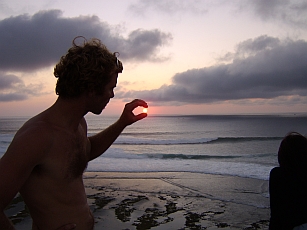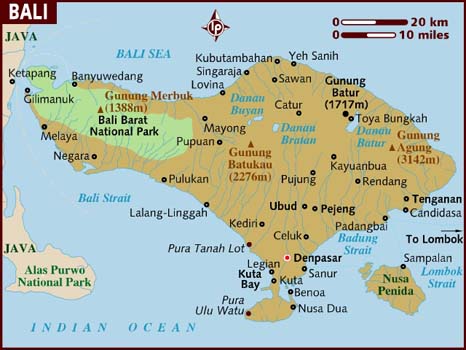In the south the land descends to form an alluvial plain, watered by shallow, north-south
flowing rivers, drier in the dry season and overflowing during periods of heavy rain.
The longest of these rivers, Sungai Ayung, is also the longest on the island (approx. 75 km).
The principal cities are the northern port of Singaraja, the former colonial capital of Bali,
and the present provincial capital and largest city, Denpasar, near the southern coast.
The town of Ubud (north of Denpasar), with its art market, museums and galleries, is arguably
the cultural centre of Bali.
Southern Bali in the foreground and Mount Agung behindThere are major coastal roads and those
that cross the island mainly north-south. Due to the mountainous terrain in the island's center,
the roads tend to follow the crests of the ridges across the mountains. There are no railway lines.
The island is surrounded by coral reefs. Beaches in the south tend to have white sand while
those in the north and west have black sand. The beach town of Padangbai in the south east has both.
The Ho River is navigable by small sampan boats. Black sand beaches between Pasut and Klatingdukuh
are being developed for tourism, but apart from the seaside temple of Tanah Lot.
To the east, the Lombok Strait separates Bali from Lombok and marks the biogeographical division
between the fauna of the Indomalayan ecozone and the distinctly different fauna of Australasia.
The transition is known as the Wallace Line, named after Alfred Russel Wallace, who first proposed
transition zone between these two major biomes. When sea levels dropped during the Pleistocene ice age,
Bali was connected to Java and Sumatra and to the mainland of Asia and shared the Asian fauna, but the
deep water of the Lombok Strait continued to keep Lombok and the Lesser Sunda archipelago isolated.



